
Francesco Solimena was a prolific Italian painter of the Baroque era, one of an established family of painters and draughtsmen.
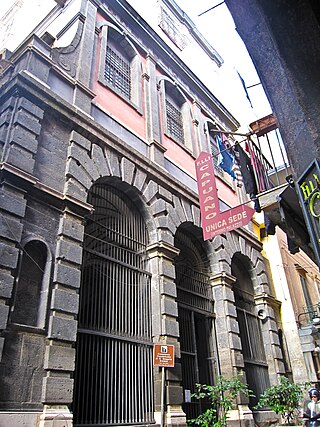
San Gregorio Armeno is a church and a monastery in Naples, Italy. It is one of the most important Baroque complexes in Naples. The church is located on a street of the same name just south of Via dei Tribunali and a few blocks south of the church of San Paolo Maggiore, Naples

Santa Chiara is a religious complex in Naples, Italy, that includes the Church of Santa Chiara, a monastery, tombs and an archeological museum. The Basilica church of Santa Chiara faces Via Benedetto Croce, which is the easternmost leg of Via Spaccanapoli. The church facade of Santa Chiara is diagonally across from the church of Gesù Nuovo.
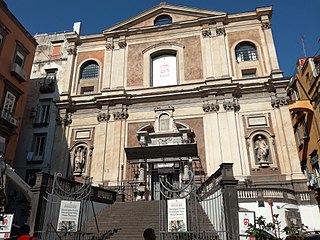
Santa Maria Donnregina Nuova is a church in central Naples, Italy. It is called Nuova ("new") to distinguish it from the older Angevin church of Santa Maria Donna Regina Vecchia.

Gesù Nuovo is the name of a church and a square in Naples, Italy. They are located just outside the western boundary of the historic center of the city. To the southeast of the spire, one can see a block away the Fountain of Monteoliveto and the piazza of the church of Sant'Anna dei Lombardi. The square is a result of the expansion of the city to the west beginning in the early 16th century under the rule of Spanish viceroy Pedro Alvarez de Toledo. The square of Gesù Nuovo contains three prominent landmarks:

Santa Maria la Nova is a Renaissance style, now-deconsecrated, Roman Catholic church and monastery in central Naples. The church is located at the beginning of a side street directly across from the east side of the main post office, a few blocks south of the Church and Monastery of Santa Chiara. Today the adjacent monastery is a meeting site and hosts the Museo ARCA of modern religious art.
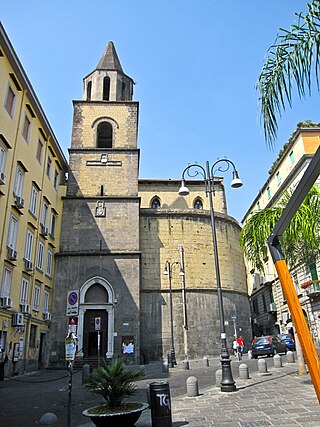
San Pietro a Majella is a church in Naples, Italy. The term may also refer to the adjacent Naples music conservatory, which occupies the premises of the monastery that used to form a single complex with the church.

Christianity and religion in general has always been an important part of the social and cultural life of Naples. It is the seat of the Archdiocese of Naples, and the Catholic faith is highly important to the people of Naples and there are hundreds of historic churches in the city. The Cathedral of Naples is the most important place of worship in the city, each year on September 19 it hosts the Miracle of Saint Januarius, the city's patron saint. In the miracle which thousands of Neapolitans flock to witness, the dried blood of Januarius is said to turn to liquid when brought close to relics said to be of his body: this is one of the most important traditions for Neapolitans.
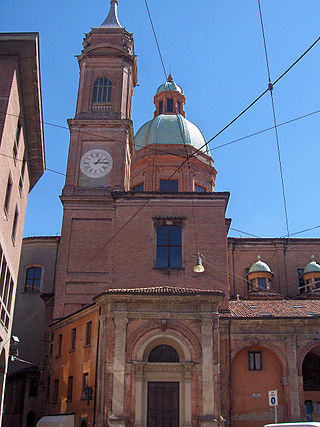
Santi Bartolomeo e Gaetano is a Renaissance style, Roman Catholic church in central Bologna; it is located near the Due Torri adjacent to the Strada Maggiore.
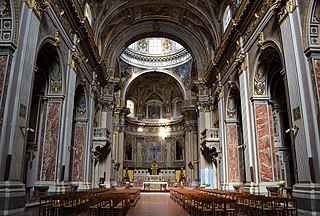
Santi Apostoli is a Baroque-style church in Naples, Italy.

Santa Maria degli Angeli a Pizzofalcone is a Baroque-style church in Naples, Italy.

San Diego all'Ospedaletto, also known as San Giuseppe Maggiore, is a Baroque-style church located on via Medina in the rione Carità in Naples, Italy. It is located across the street from the tall modern NH Ambassador Hotel and diagonal from the Palazzo Giordano and Questura.

Santa Maria Regina Coeli is a Roman Catholic church in central Naples, Italy.

Santa Maria Egiziaca a Forcella is a Baroque-style, Roman Catholic church located in the quartiere di Forcella, in the city of Naples, Italy;

The Basilica of San Giovanni Maggiore is a church in Largo San Giovanni Maggiore in central Naples, Italy.

The church of Santi Severino e Sossio and the annexed monastery are located on via Bartolommeo Capasso in Naples, Italy.
Arcangelo Guglielmelli was an Italian architect and painter, active in his native Naples, Italy, in a late-Baroque style. He was involved in the building and reconstruction of churches, many of which had been damaged by the earthquakes of 1688 and 1694.

The church of the Croce di Lucca is a religious edifice in central Naples, Italy, on the Via dei Tribunali.

The Palazzo Zevallos Stigliano is a Baroque palace located on Via Toledo number 185 in the quartiere San Ferdinando of central Naples, Italy. It is also called the Palazzo Zevallos or Palazzo Colonna di Stigliano, and since 2014 serves as a museum of artworks, mainly spanning the 17th through the early 20th centuries, sponsored by the Cultural Project of the bank Intesa Sanpaolo. This museum is linked to the Museum or Gallerie di Piazza Scala in Milan and the Museum at Palazzo Leoni Montanari in Vicenza, also owned by the Bank.
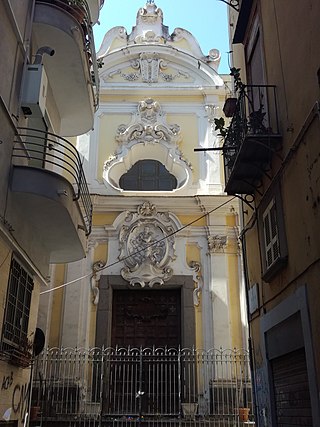
Santa Maria Avvocata is a Catholic church located at the end of Via Avvocata in Piazza Dante in the Historic Center of Naples, Italy.





























